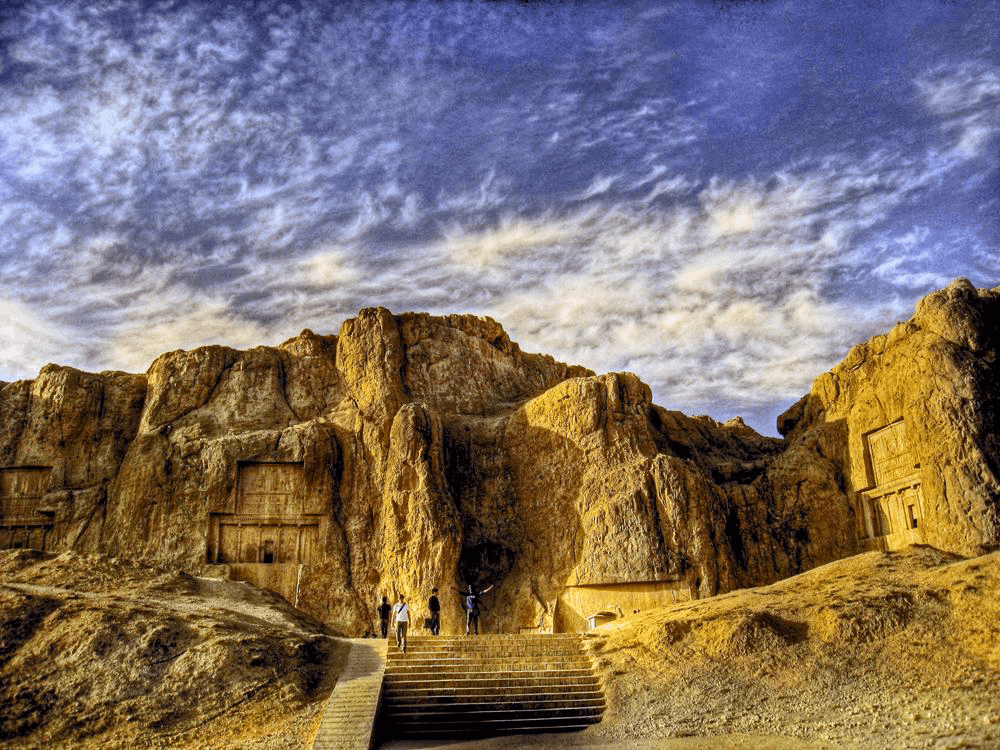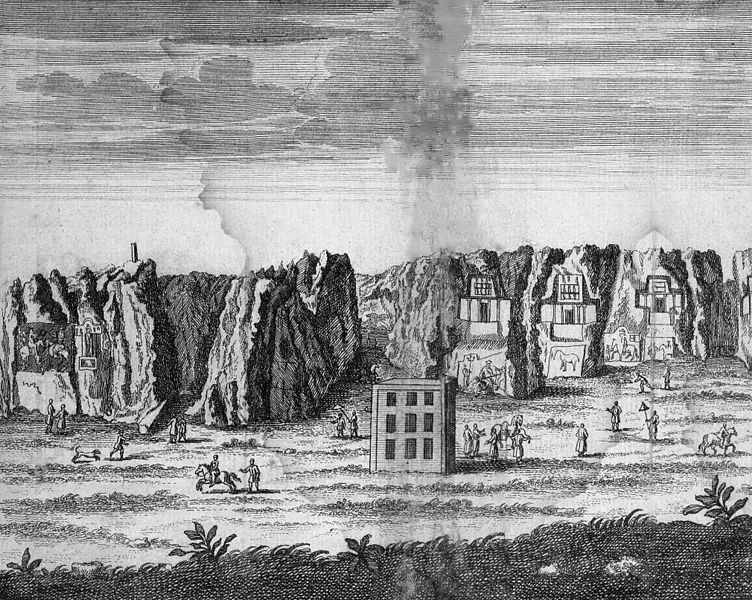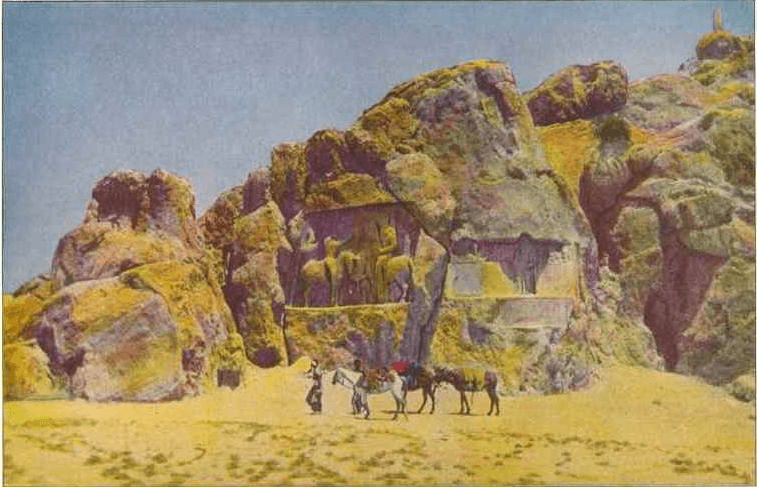Persian Structures > Naqsh-e-Rustam
Naqsh-e-Rustam
Naqsh-e Rustam is an ancient necropolis located about 12 kilometers northwest of Persepolis, in Fars Province, Iran. It is one of the most significant archaeological sites of the Achaemenid and Sassanian periods. The site is renowned for its impressive rock-cut tombs of Achaemenid kings, including Darius I, Xerxes I, Artaxerxes I, and Darius II, as well as several Sassanian rock reliefs. There is a fifth and unfinished tomb that people attribute to either Artaxerxes III who reigned for two years or possibly for Darius III which is most likely as he was killed early in his reign
Key Features of Naqsh-e Rustam
Achaemenid Rock-Cut Tombs:
- Tomb of Darius I: One of the most prominent tombs at Naqsh-e Rustam, the tomb of Darius I, features a grand cross-shaped facade with a central entrance leading to the burial chamber. The facade is decorated with detailed reliefs depicting the king receiving divine sanction from Ahura Mazda, the chief deity of Zoroastrianism.
- Tomb of Xerxes I: Similar in design to the tomb of Darius I, the tomb of Xerxes I also has a cross-shaped facade and is adorned with reliefs showing the king in a pose of reverence before Ahura Mazda, flanked by attendants and supported by figures representing subject peoples.
- Other Royal Tombs: The site includes the tombs of other Achaemenid kings, such as Artaxerxes I and Darius II, which follow the same architectural and decorative style. These tombs emphasize the divine right of the Achaemenid kings and their authority over a vast empire.
Sassanian Rock Reliefs:
- Investiture Reliefs: Several Sassanian reliefs depict the investiture of kings, where the monarch receives the royal diadem from a divine figure, typically Ahura Mazda. These reliefs highlight the continuity of royal iconography from the Achaemenid to the Sassanian period.
- Victory Reliefs: Some reliefs at Naqsh-e Rustam commemorate military victories of Sassanian kings. Notable examples include the relief of Shapur I's triumph over the Roman emperors Valerian and Philip the Arab, showcasing the might and prowess of the Sassanian military.
- Equestrian Reliefs: Other reliefs depict royal hunting scenes and equestrian portraits of Sassanian kings, emphasizing their valor and skill as hunters and warriors.
Ka'ba-ye Zartosht:
- Zoroastrian Structure: Located near the rock-cut tombs is the Ka'ba-ye Zartosht, a square tower-like structure believed to be associated with Zoroastrianism. Its exact function remains uncertain, but it may have served as a fire temple, a depository for sacred texts, or a royal tomb.
Historical and Cultural Significance
Symbol of Royal Power:
- Achaemenid Legacy: The rock-cut tombs of the Achaemenid kings symbolize the power and authority of the Achaemenid Empire. The grand facades and detailed reliefs emphasize the divine sanction of the kings and their control over a vast and diverse empire.
- Sassanian Continuity: The Sassanian reliefs at Naqsh-e Rustam reflect the continuity of royal iconography and the importance of divine legitimacy in Persian kingship. The investiture and victory scenes underscore the Sassanian kings' claims to Achaemenid heritage and their role as protectors of Zoroastrianism.
Architectural and Artistic Achievements:
- Rock-Cut Architecture: The construction of rock-cut tombs and reliefs at Naqsh-e Rustam showcases the advanced engineering and artistic skills of the Achaemenid and Sassanian periods. The precise carving and intricate details demonstrate the high level of craftsmanship achieved by Persian builders and sculptors.
- Religious Significance: The Zoroastrian elements in the reliefs and the Ka'ba-ye Zartosht highlight the religious significance of Naqsh-e Rustam. The site reflects the integration of religious and royal imagery in Persian art and architecture.
Archaeological Significance
Excavations and Discoveries:
- Structural Remains: Archaeological excavations at Naqsh-e Rustam have revealed the remains of the rock-cut tombs and reliefs, providing valuable insights into the construction techniques and artistic traditions of the Achaemenid and Sassanian periods.
- Artifacts: Various artifacts, including pottery, tools, and inscriptions, have been discovered at the site. These artifacts offer a glimpse into the daily life and material culture of the people who lived and worked in the region.
Preservation and Study:
- UNESCO World Heritage Site: Naqsh-e Rustam is part of the UNESCO World Heritage Site that includes Persepolis. Preservation efforts focus on protecting the site from environmental and human damage, ensuring its historical and cultural significance is maintained for future generations.
- Ongoing Research: Scholars continue to study the tombs and reliefs at Naqsh-e Rustam to gain a deeper understanding of Achaemenid and Sassanian art, architecture, and religious practices. The site remains a key focus for research into ancient Persian history.
Conclusion
Naqsh-e Rustam is a remarkable archaeological site that offers a unique window into the architectural, artistic, and cultural achievements of the Achaemenid and Sassanian periods. The grand rock-cut tombs, intricate reliefs, and the Ka'ba-ye Zartosht reflect the enduring legacy of Persian kingship and the integration of royal and religious imagery. As a UNESCO World Heritage Site, Naqsh-e Rustam continues to be a vital resource for understanding the history and heritage of ancient Persia, providing valuable insights into the empire's political, cultural, and religious life. Ongoing preservation and research efforts ensure that this significant site remains accessible and informative for future generations.

Naqsh-e Rustam Photo (Present Day)

Naqsh-e Rustam - Jean Chardin (1723)

Naqsh-e Rustam

Naqsh-e Rustam Photo (1921)
- Achaemenid Archers
- Achaemenid Cavalry
- Achaemenid Empire Battles
- Achaemenid Empire Naval Battles
- Achaemenid Empire Sieges
- Achaemenid Empire Wars
- Achaemenid Invasion Of The Indus Valley
- Achaemenid Military Units
- Achaemenid Military
- Achaemenid Tactics
- Acinaces
- Battle Of Artemisium
- Battle Of Cnidus
- Battle Of Cunaxa
- Battle Of Cyzicus
- Battle Of Haliartus
- Battle Of Hyrba
- Battle Of Lade
- Battle Of Lechaeum
- Battle Of Marathon
- Battle Of Mycale
- Battle Of Nemea
- Battle Of Opis
- Battle Of Pelusium 525 BC
- Battle Of Plataea
- Battle Of Pteria
- Battle Of Salamis
- Battle Of The Eclipse Halys
- Battle Of The Eurymedon
- Battle Of The Persian Border
- Battle Of Thermopylae
- Battle Of Thymbra
- Cadusian Campaign Of Artaxerxes II
- Campaign Of Alexander The Great
- Campaign Of Cyrus II The Great
- Cardaces
- Corinthian War
- Earth And Water
- Fall Of Babylon
- Fall Of Ecbatana
- First Persian Invasion Of Greece
- Great Satraps Revolt
- Greco Persian Wars
- Ionian Revolt
- Lydo Median War
- Medo Persian War
- Peace Of Antalcidas
- Peace Of Callias
- Peloponnesian War
- Persian Immortals
- Scythian Campaign Of Darius I
- Second Persian Invasion Of Greece
- Siege Of Babylon
- Siege Of Eretria
- Siege Of Kitium
- Siege Of Naxos 499 BC
- Siege Of Pasargadae Hill
- Siege Of Sardis 498 BC
- Siege Of Sardis 547 BC
- Siege Of Sestos
- Sparabara
- Takabara
- Ten Thousand
- Wars Of The Delian League